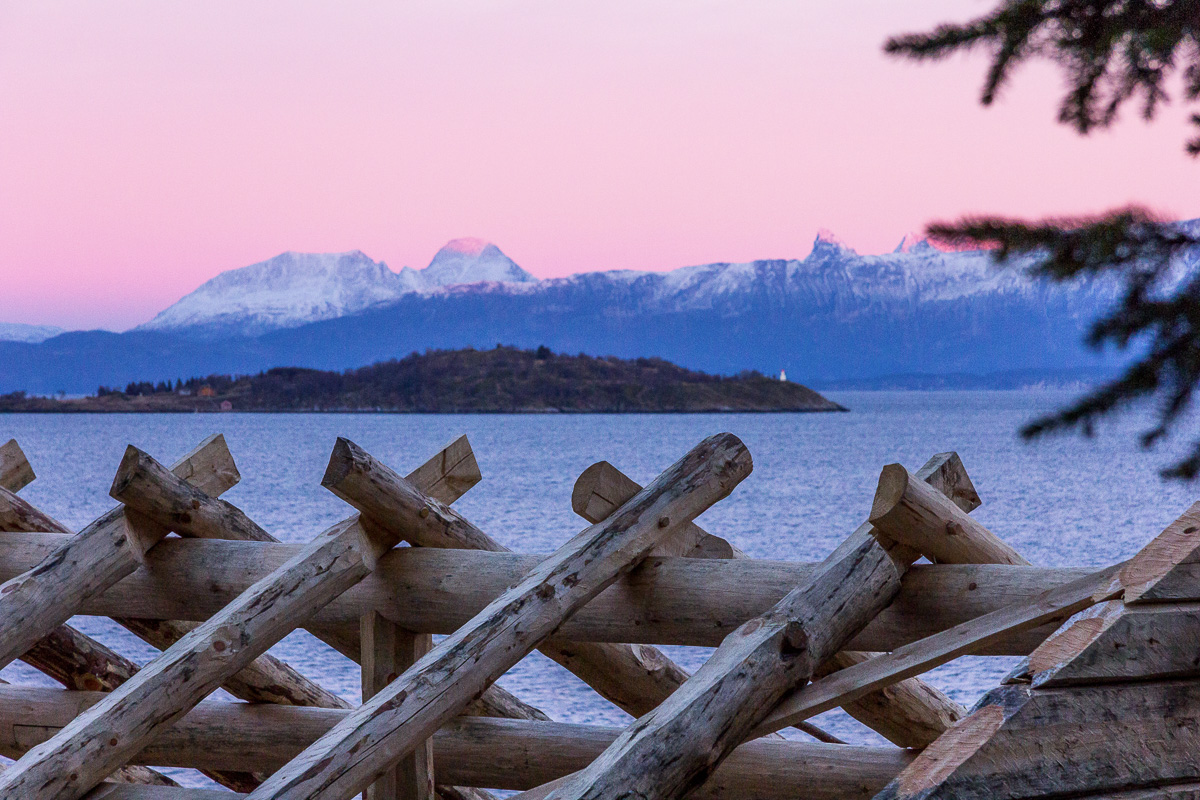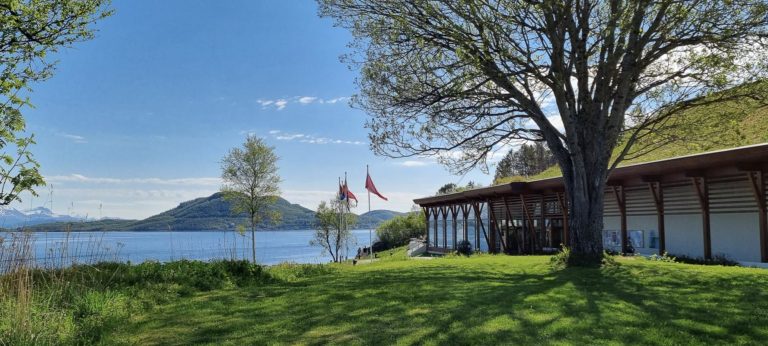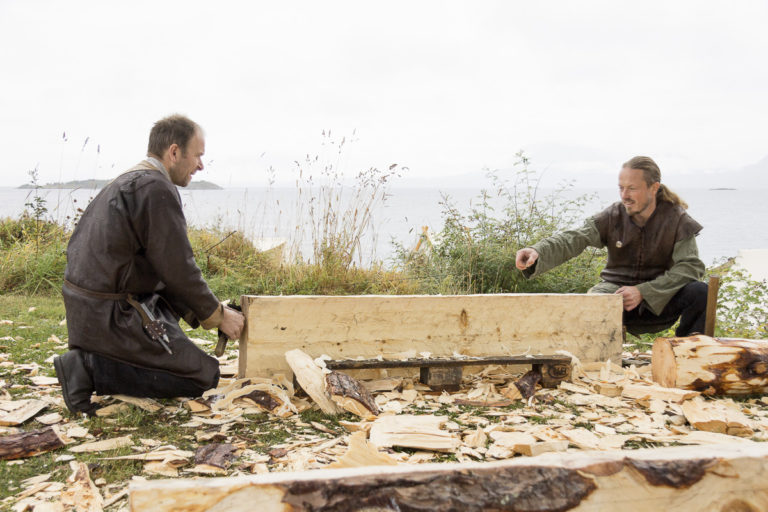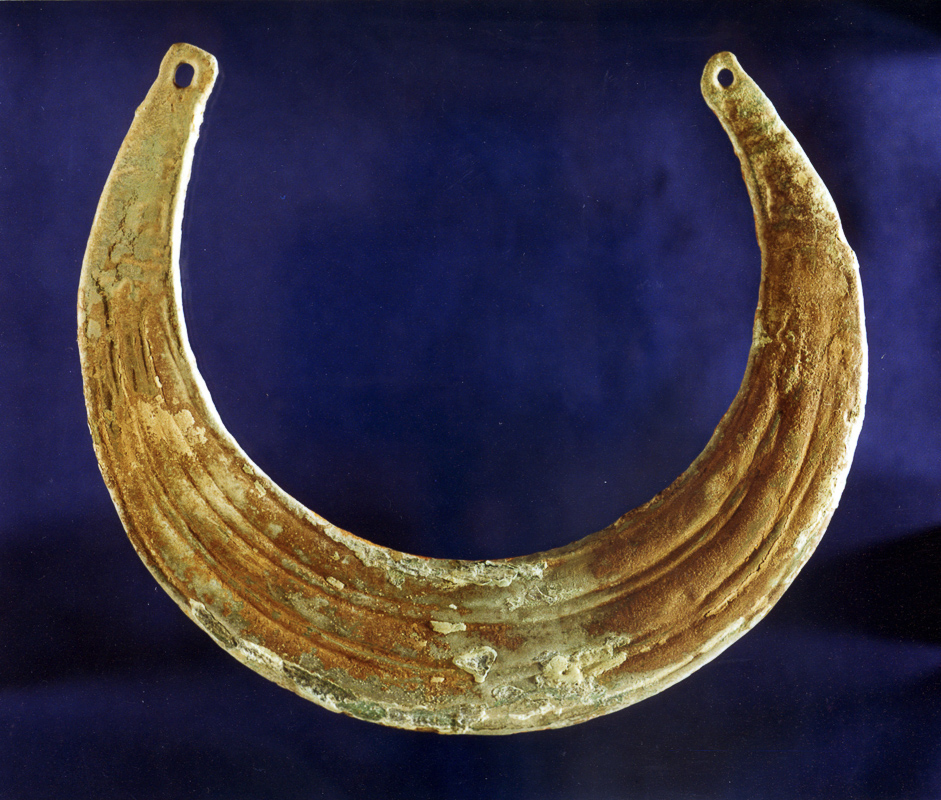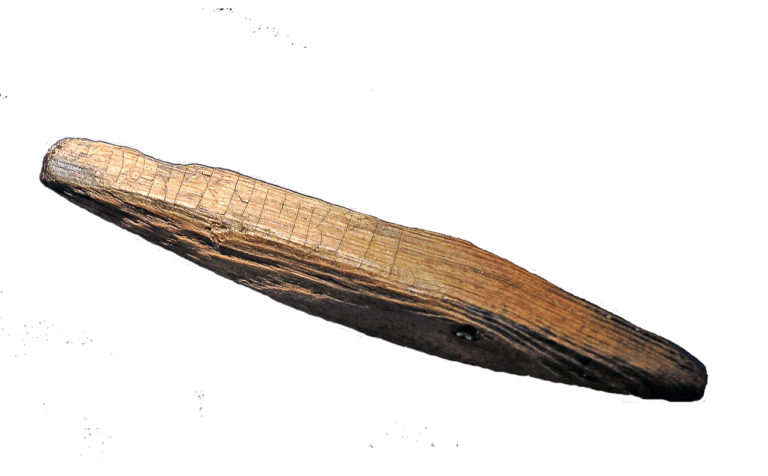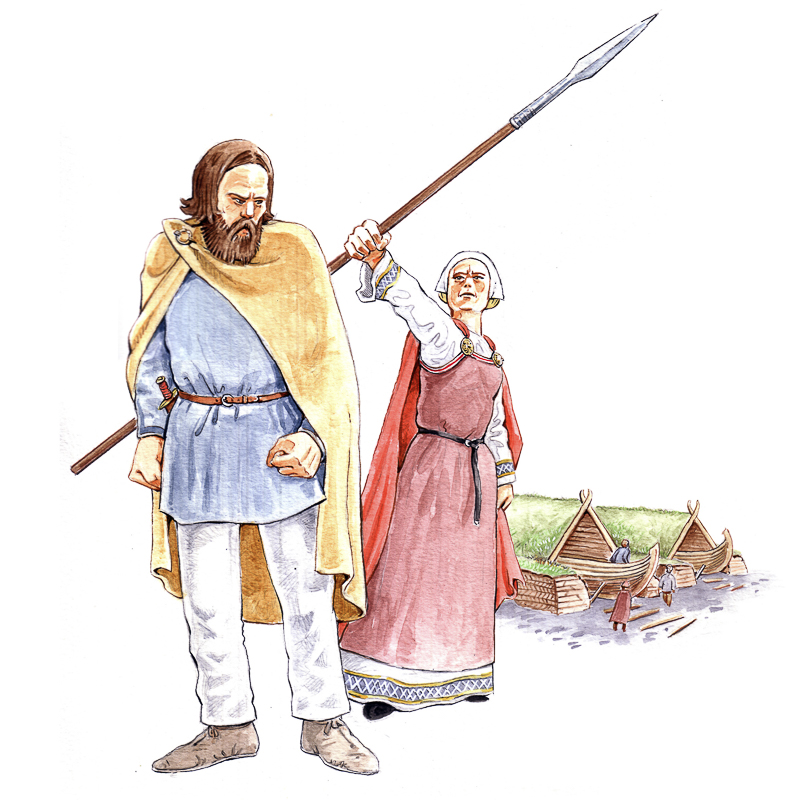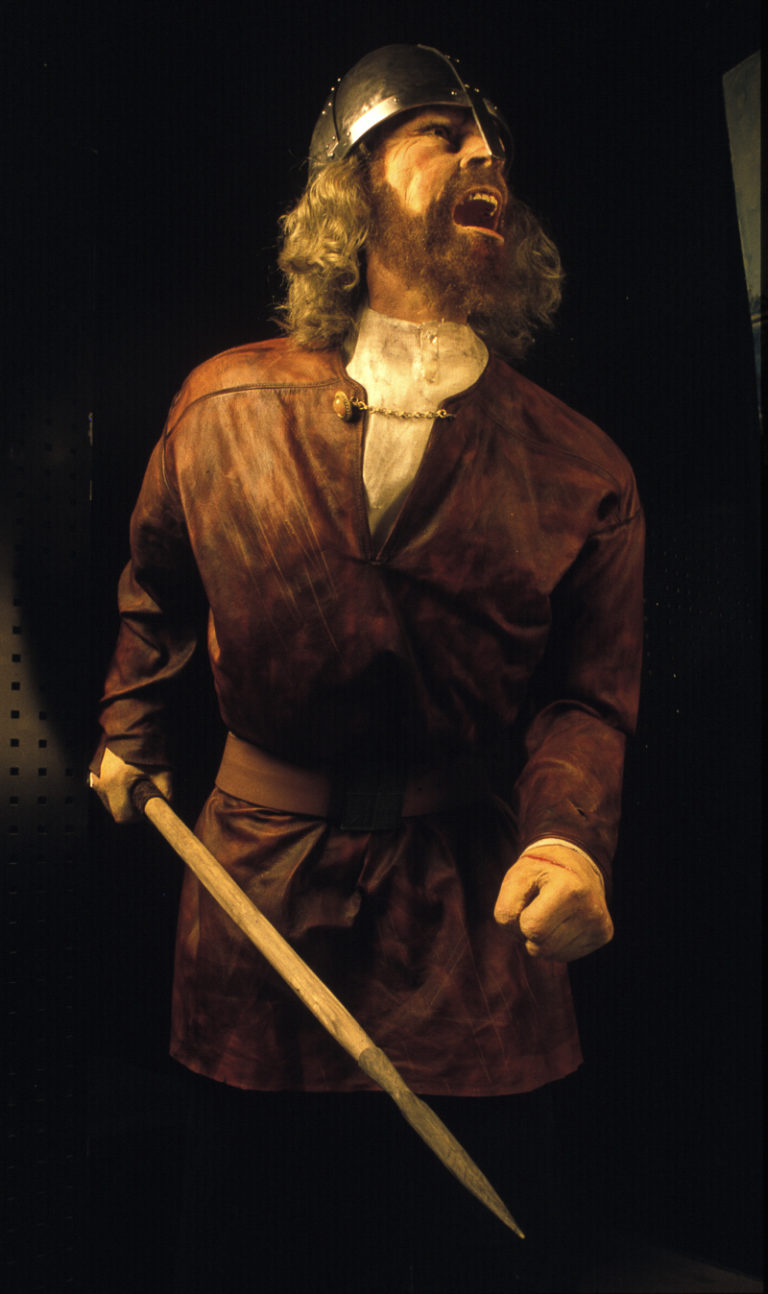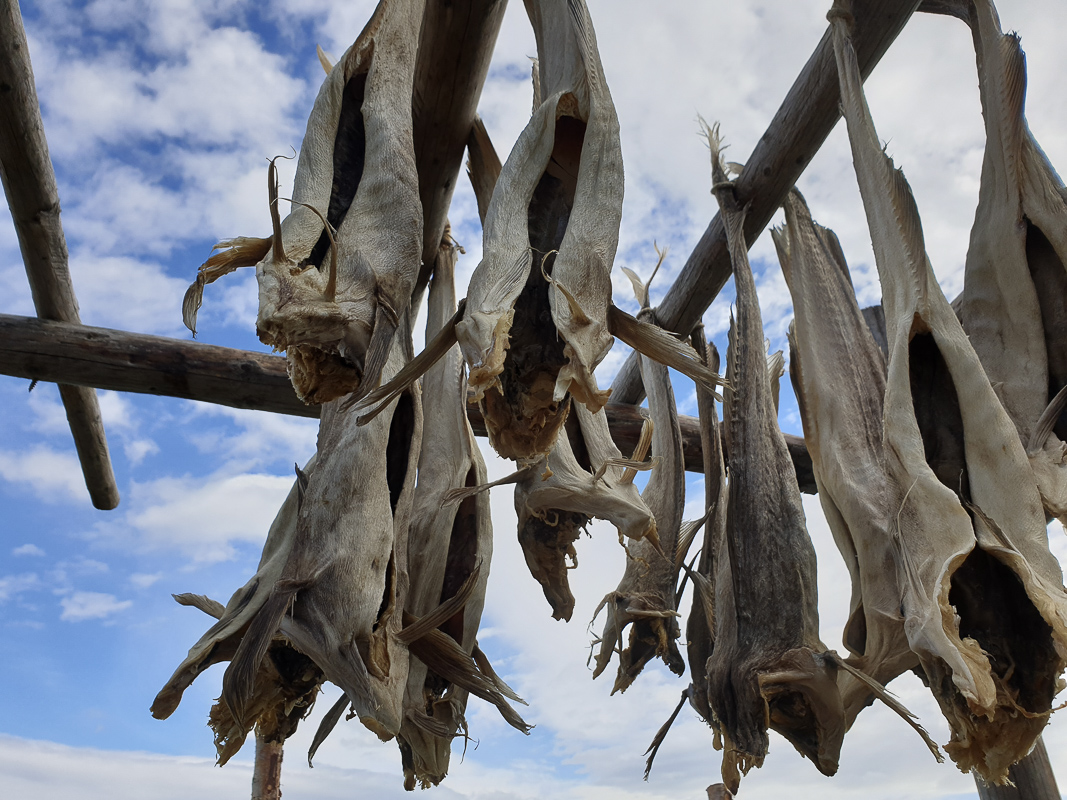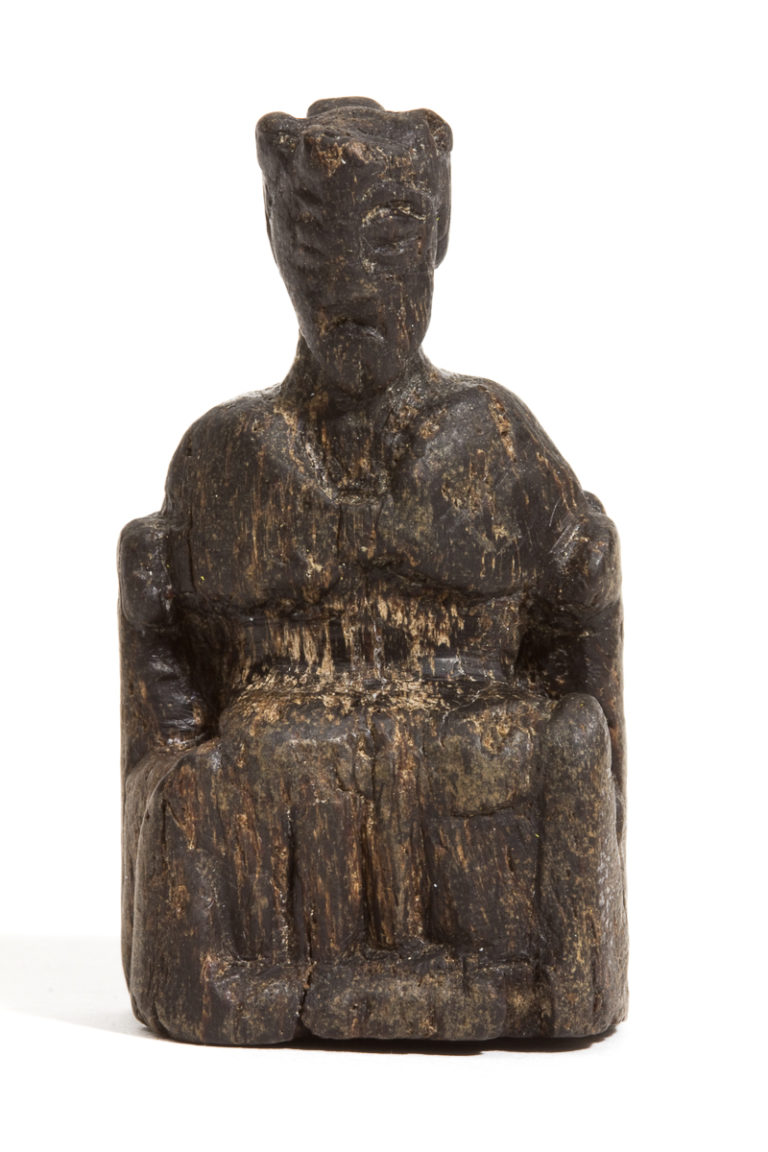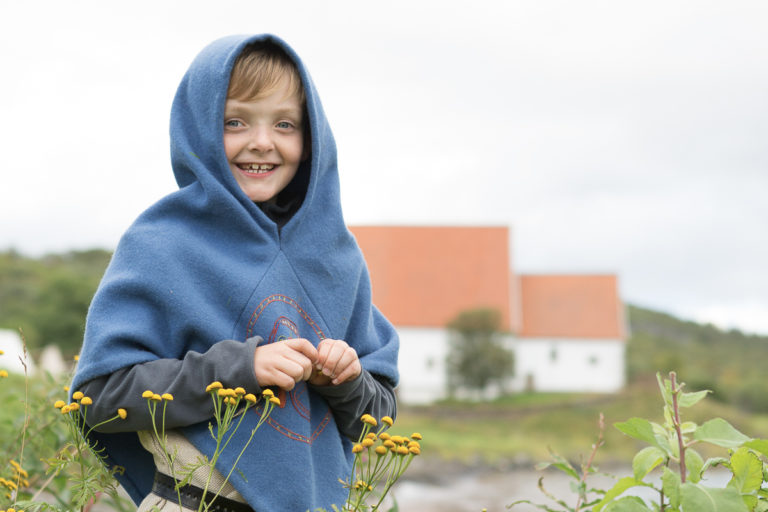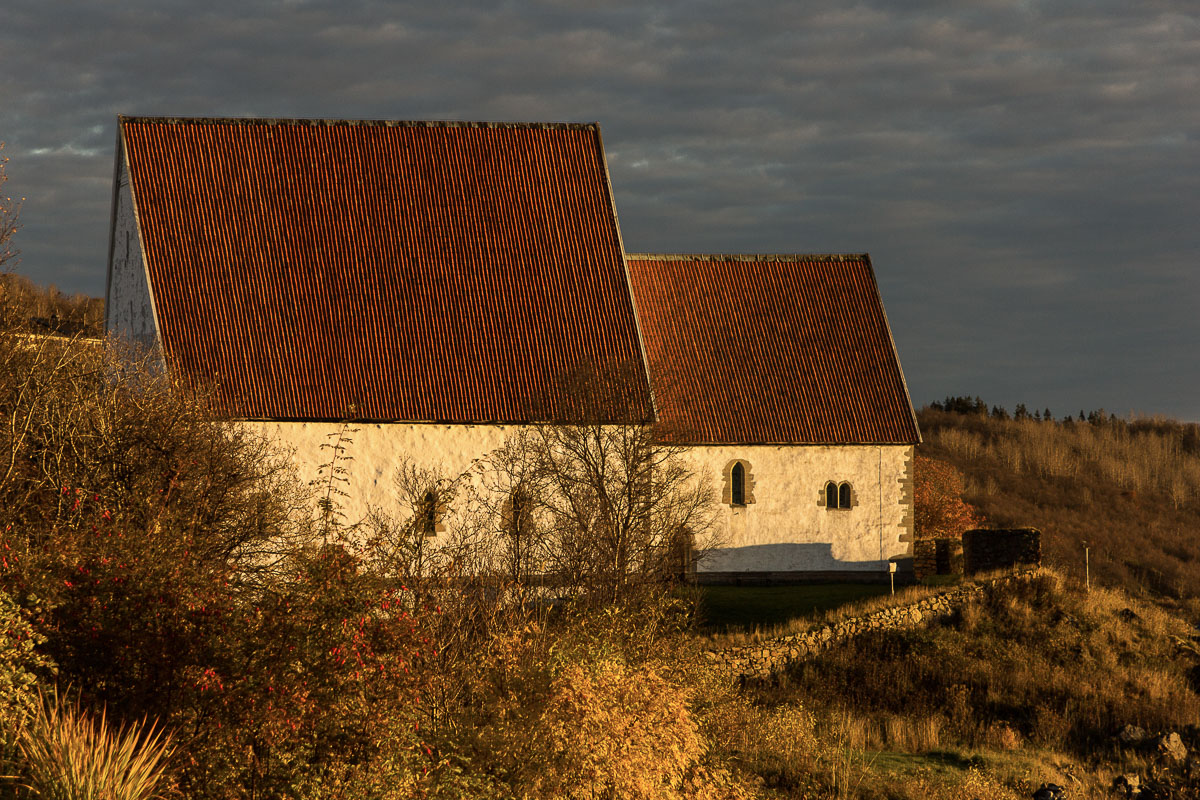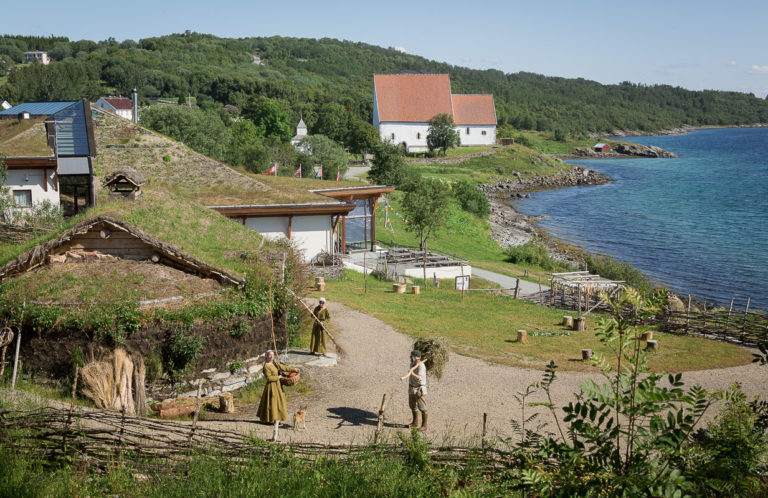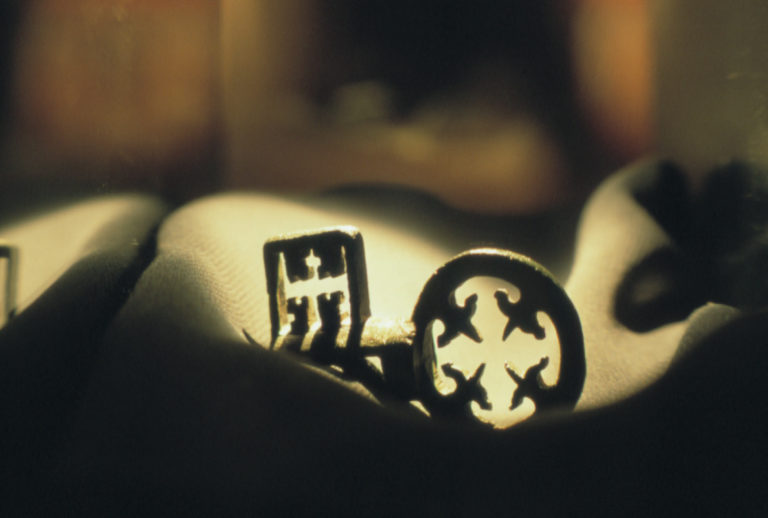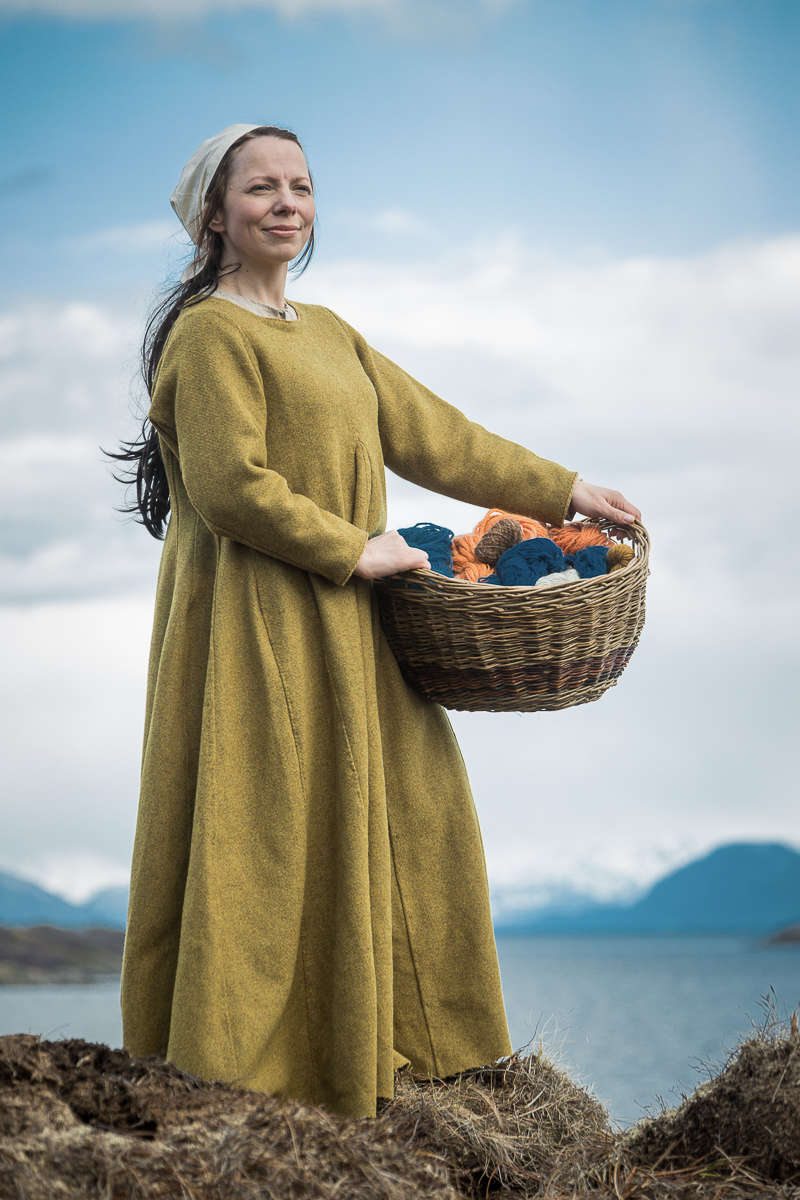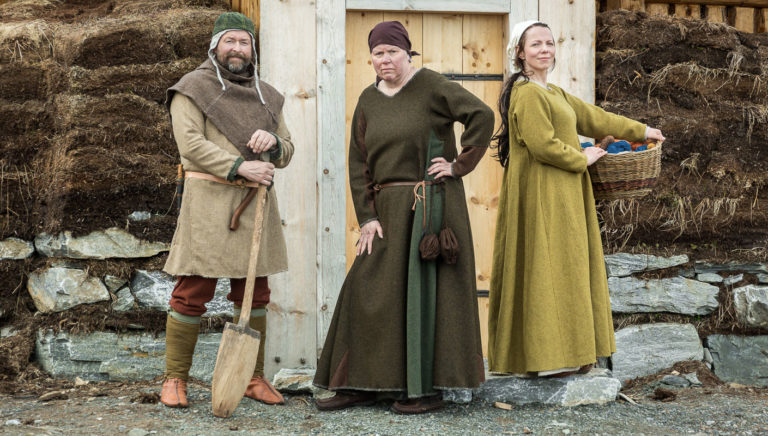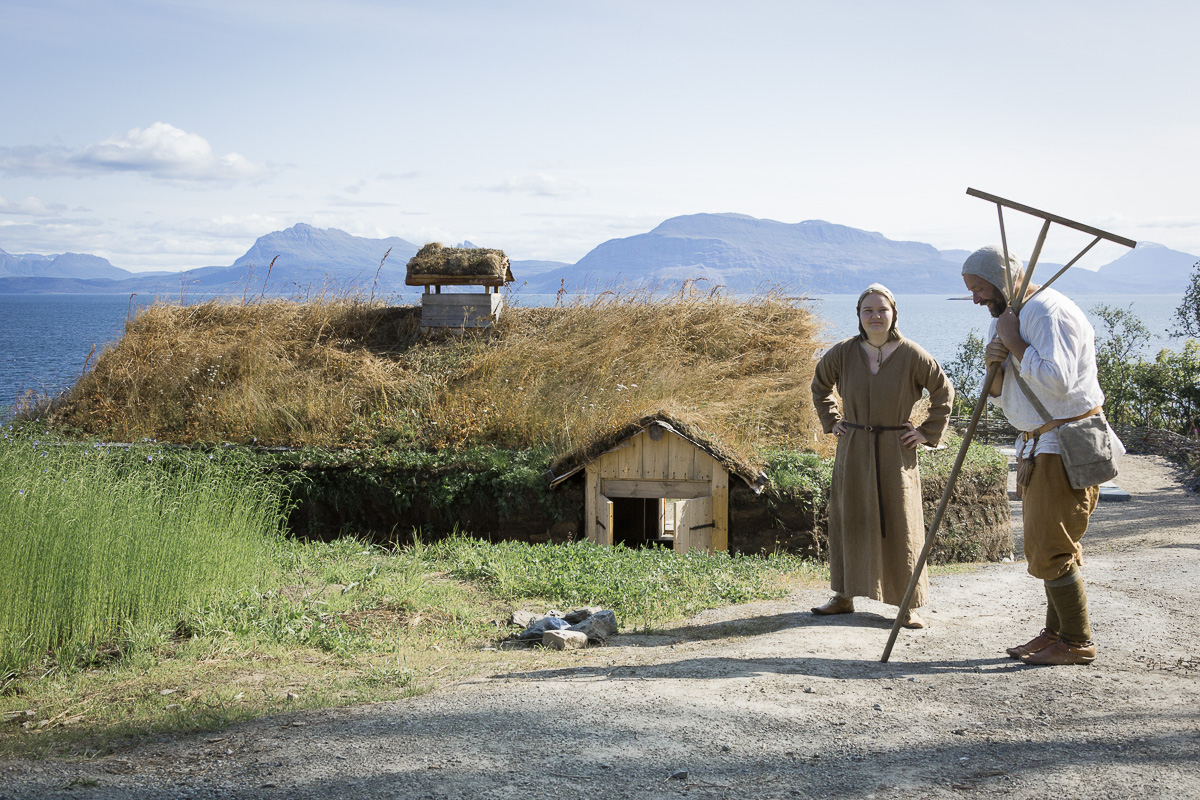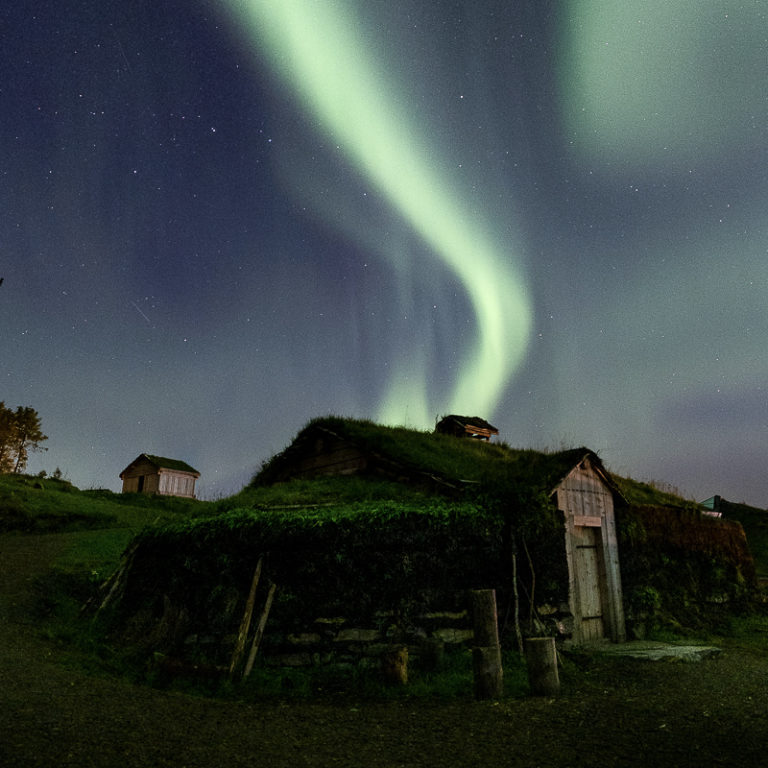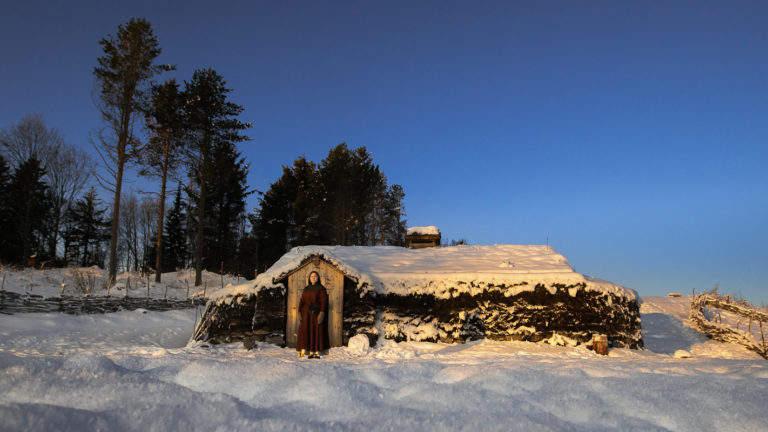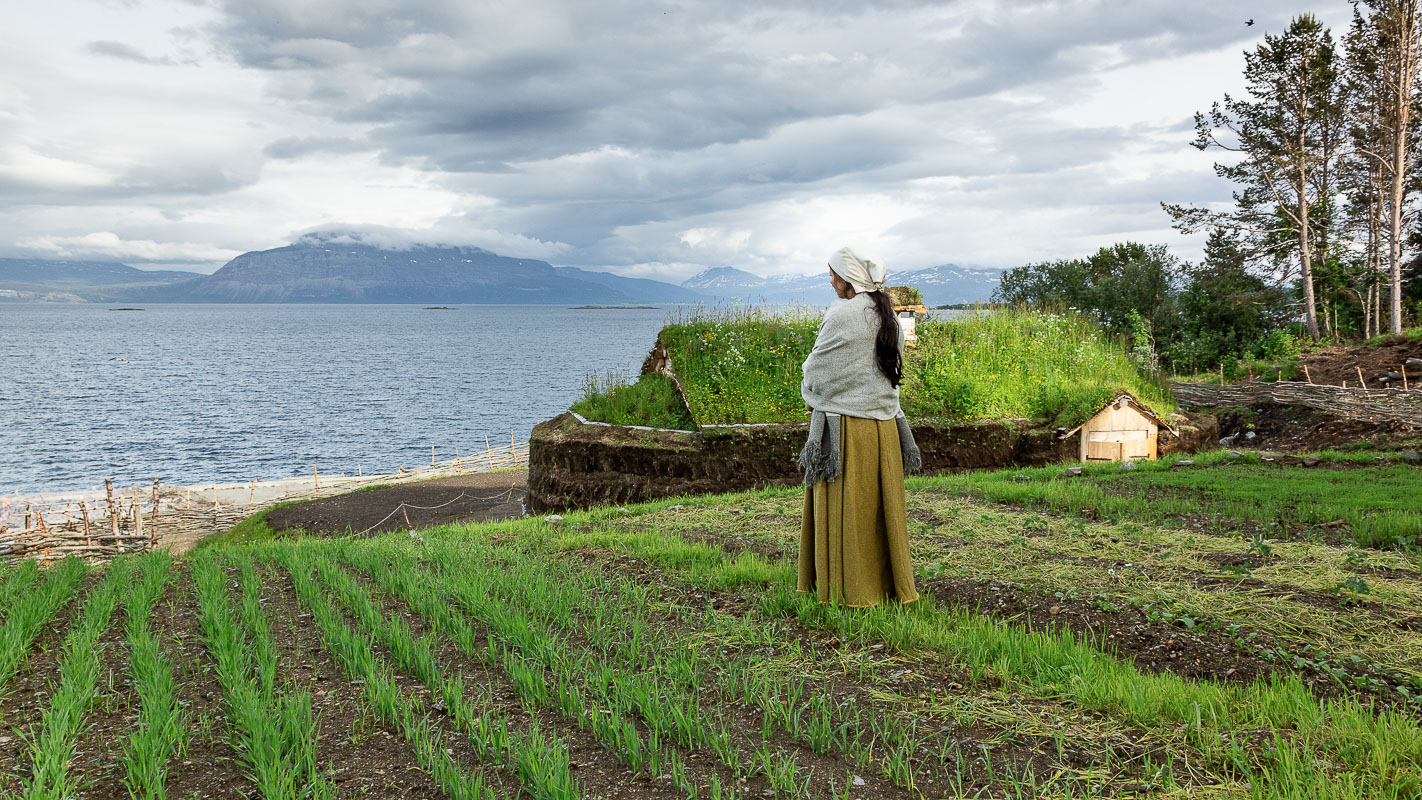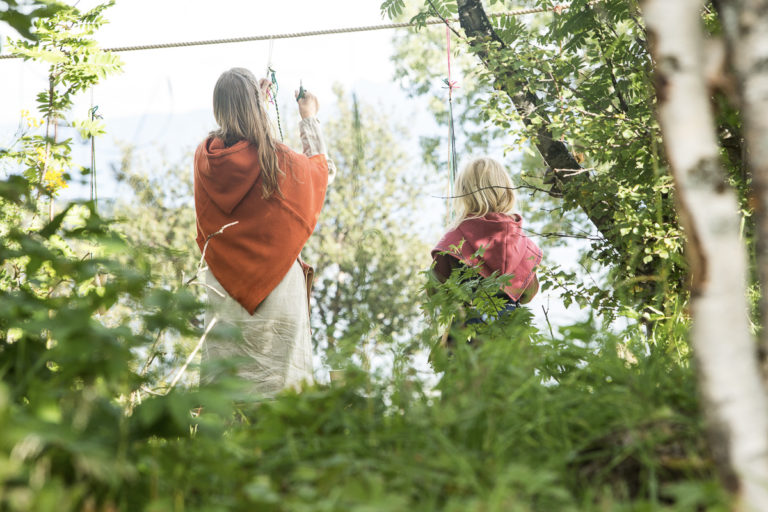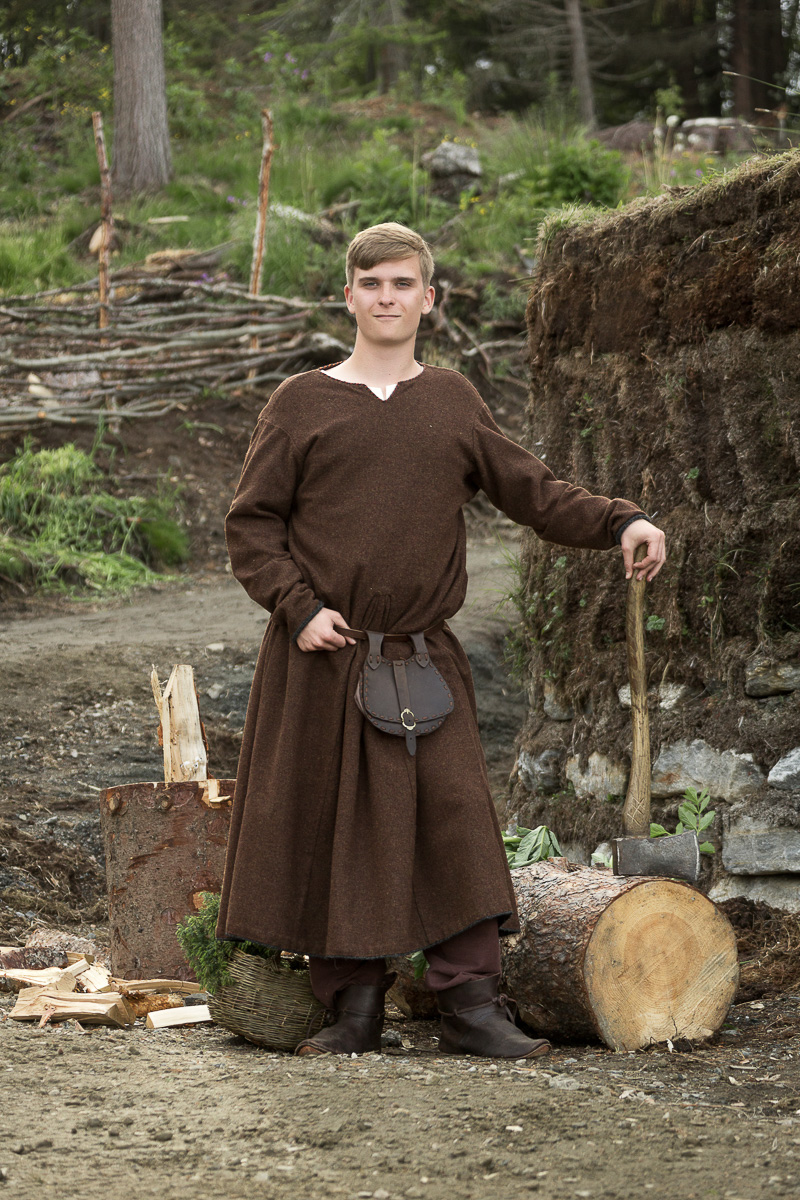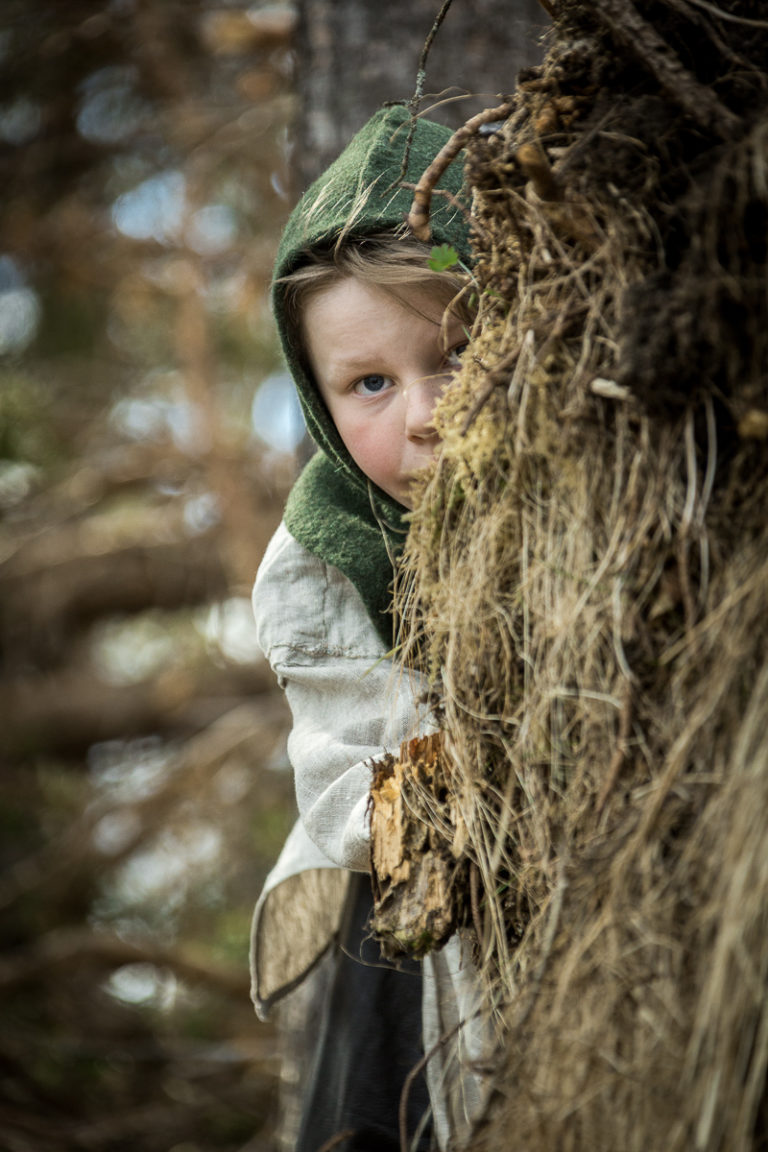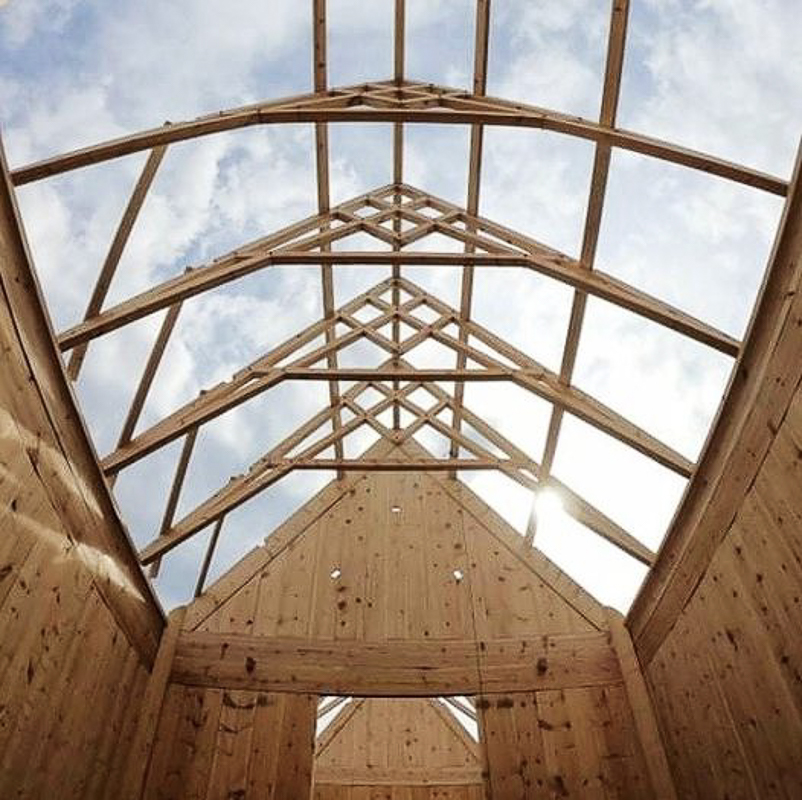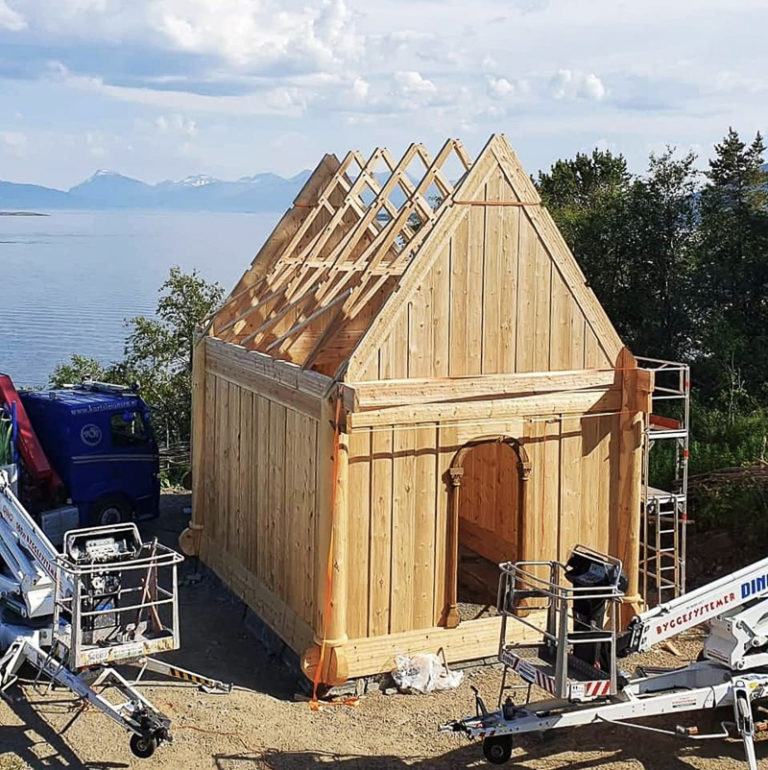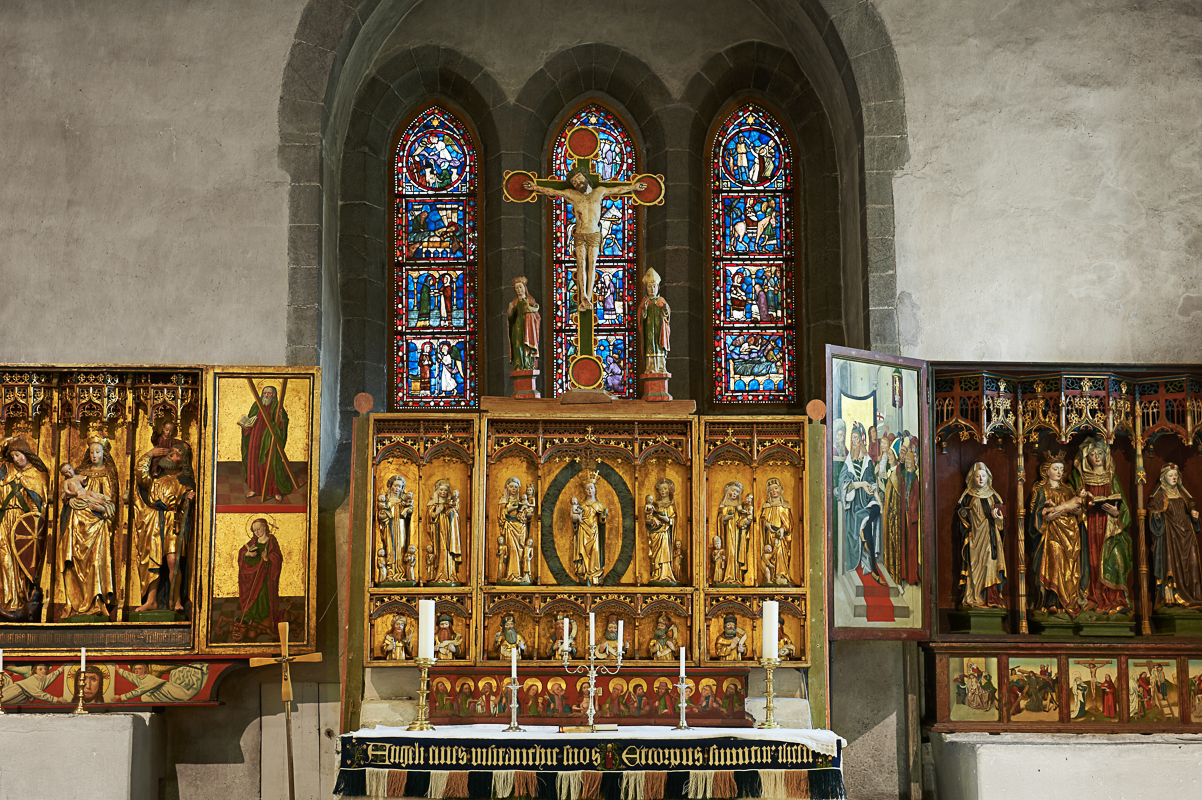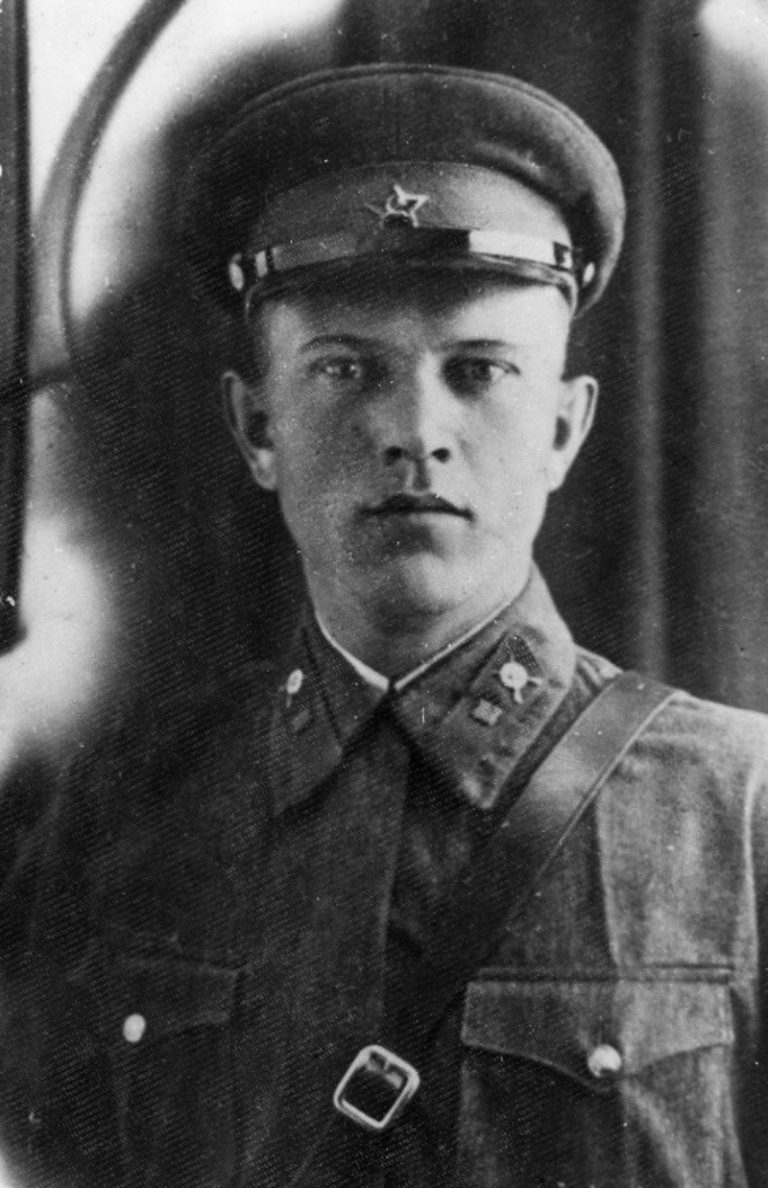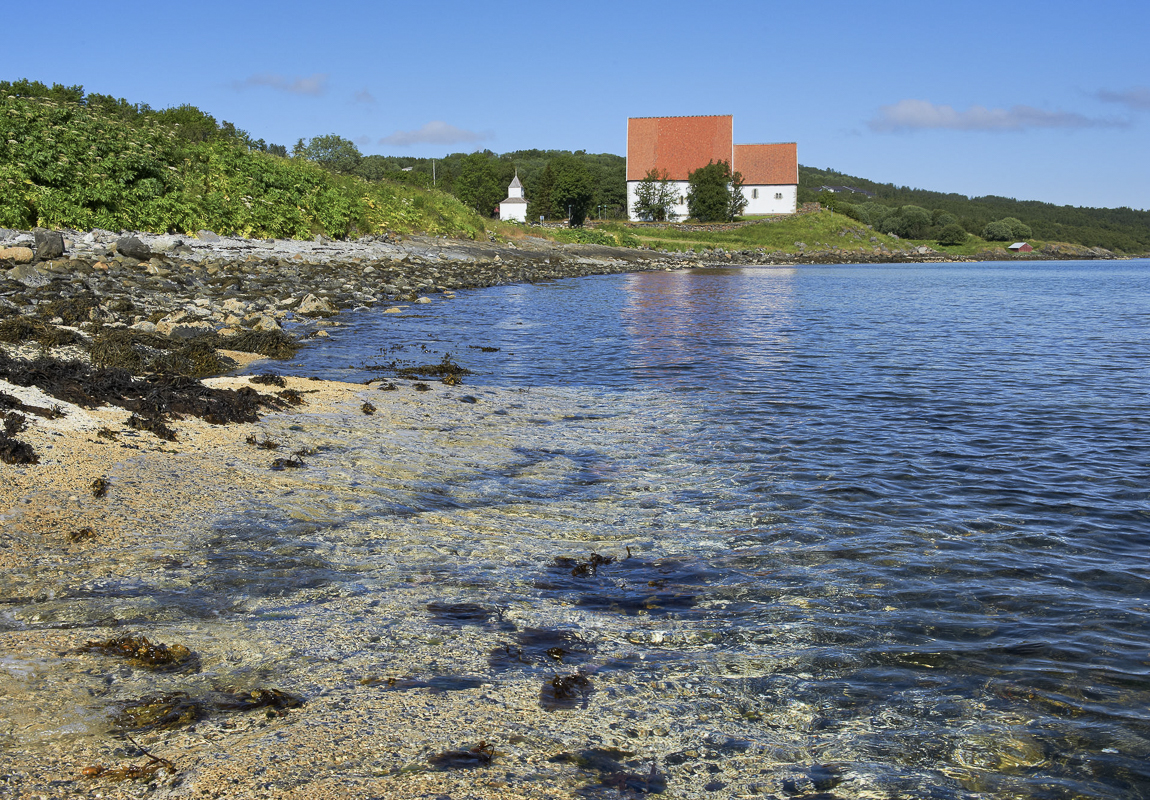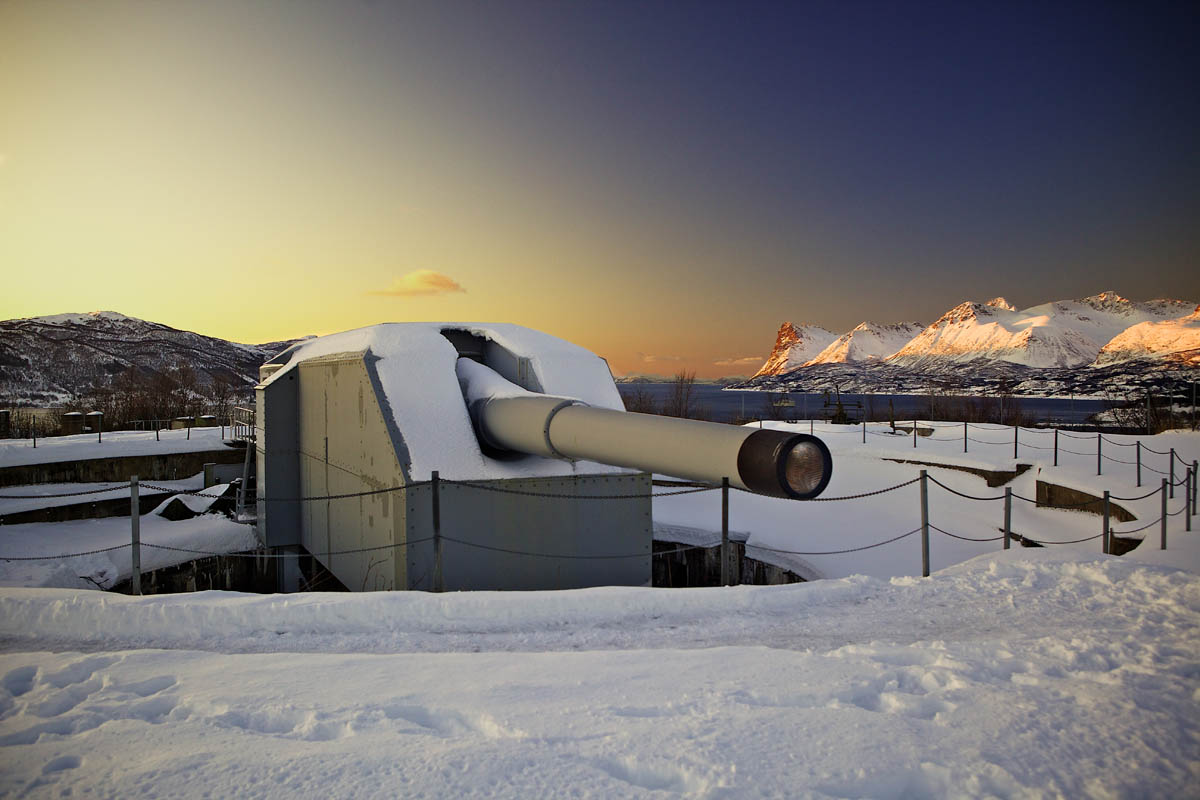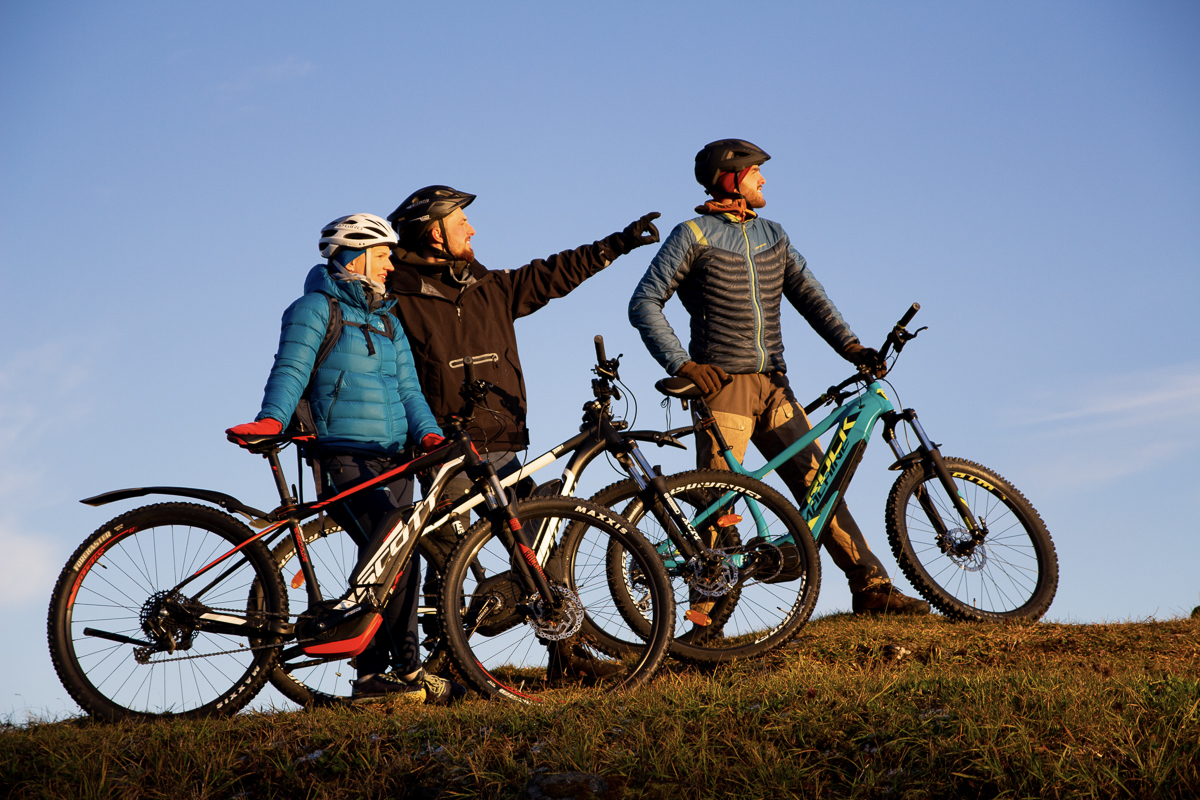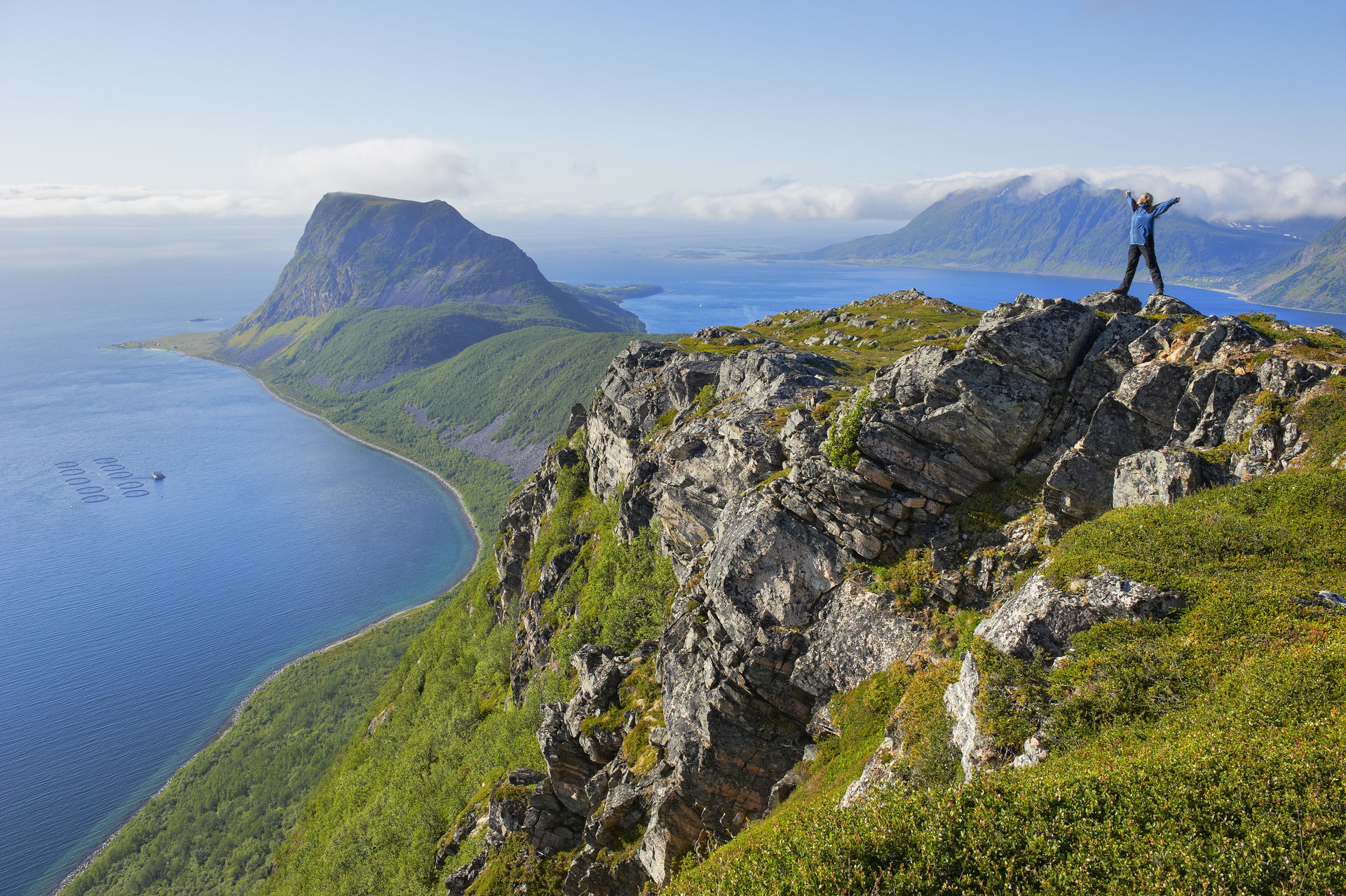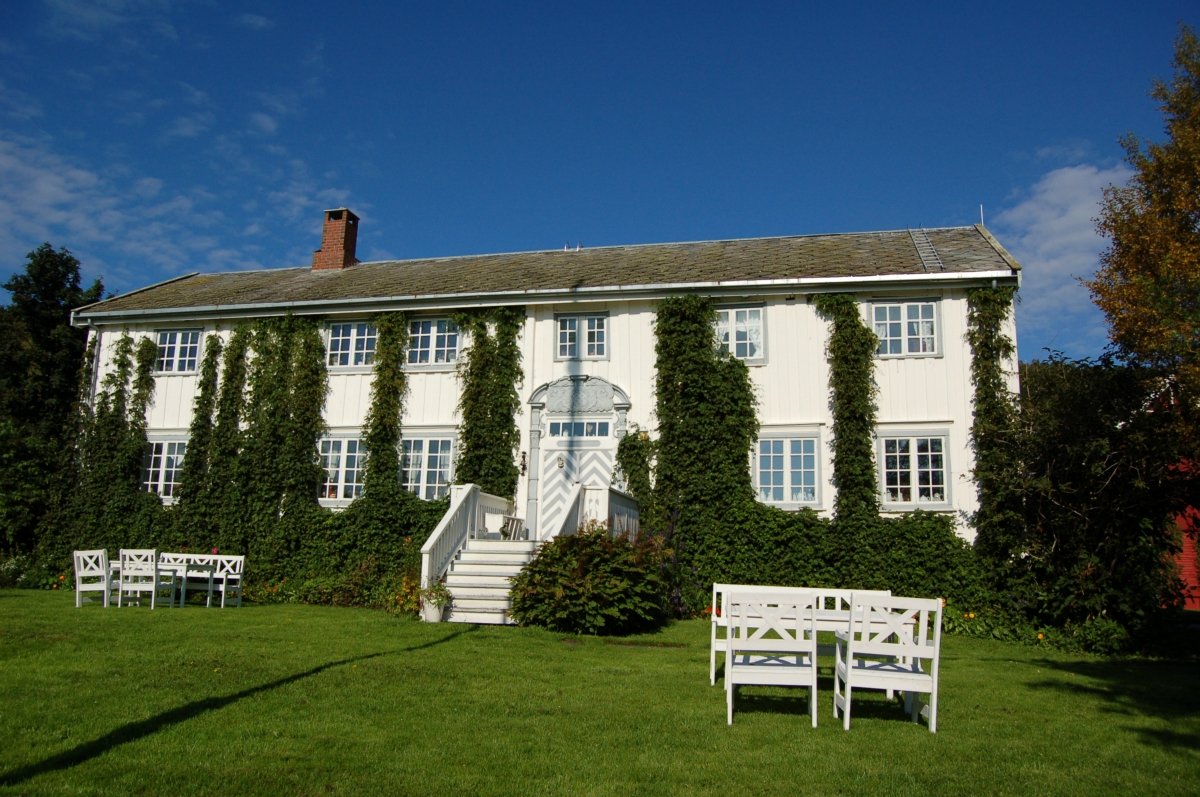A 2500 year old bronze necklace found in the skerries is proof of an ancient and grandiose history around Trondenes. The people of the region played an important role in the drama surrounding the Christianisation of Norway a thousand years ago. One of the nation’s most impressive country churches from the Middle Ages stands here. Trondenes Historical Center puts everything into context in beautiful exhibitions. You have to go outside later and meet Jorunn the housewife, Lame Haldor, Grubby Gunvor and the other people who live in and around the Trondenes medieval farm. You have probably never been so close to the Middle Ages.
Beautiful objects emerge from the darkness of history
A 2500 year old collar once adorned a woman’s neck. The woman who found the collar on the shores of Trondenes thought it was a bit of scrap from the war. It was imported from a Scandinavian Bronze Age culture further south and tells us that trade routes existed way back then. A bronze cauldron found in a bog at Bjarkøya was dated to 275 AD. The theory is that it was a sacrificial cauldron. It holds almost 250 liters, and is thus the largest of its kind in Norway. Expensive objects like this are an indication that Bjarkøy was already a power center in Northern Norway during the Iron Age.
Trondenes was the border of Hålogaland
During the Iron Age, the Viking Age and into the Middle Ages, the southern part of Northern Norway was populated by a Norse people, referred to as Hålogaland, while the northern parts were dominated by the Sami, called Finnmǫrk. We do not know exactly where the border ran, and it certainly changed over a long period of time. In any case, Bjarkøy and Trondenes were the two northernmost chiefdoms in Hålogaland dominating the fjords and straits around Vågsfjorden and over to the Senja side. That put them close to the Sami and their rich resources.
Trading with the Sami was the basis of the chiefdoms’ power
The Sami during this period (then called the Finns) could supply luxury products that were in demand in Europe, primarily furs. The fur from marten, ermine and lynx were bought by powerful men and women all over Europe. Contact and trade with the Sami was of great importance back then. The chieftain Ottar from Hålogaland, who visited King Alfred’s court in England around 890 (and who may well have lived at Trondenes) seems to have ruled over the Sami. His farm was unimpressive to the English, but his wealth and position were built on trading with the Sami.
Bring what you need with you to the grave
Several hundred round tumulus burial mounds were found around Vågsfjorden. In the Merovingian period (600-800 AD), people were often buried without any visible markings above the ground. It was common to bury objects that might be useful in the next life. The women often wore bronze jewelry and pearls. These could come from far away, such as the Finnish-speaking areas in the southeast, from Russia and from the Frankish Empire. It shows trade relations that reached far and wide.
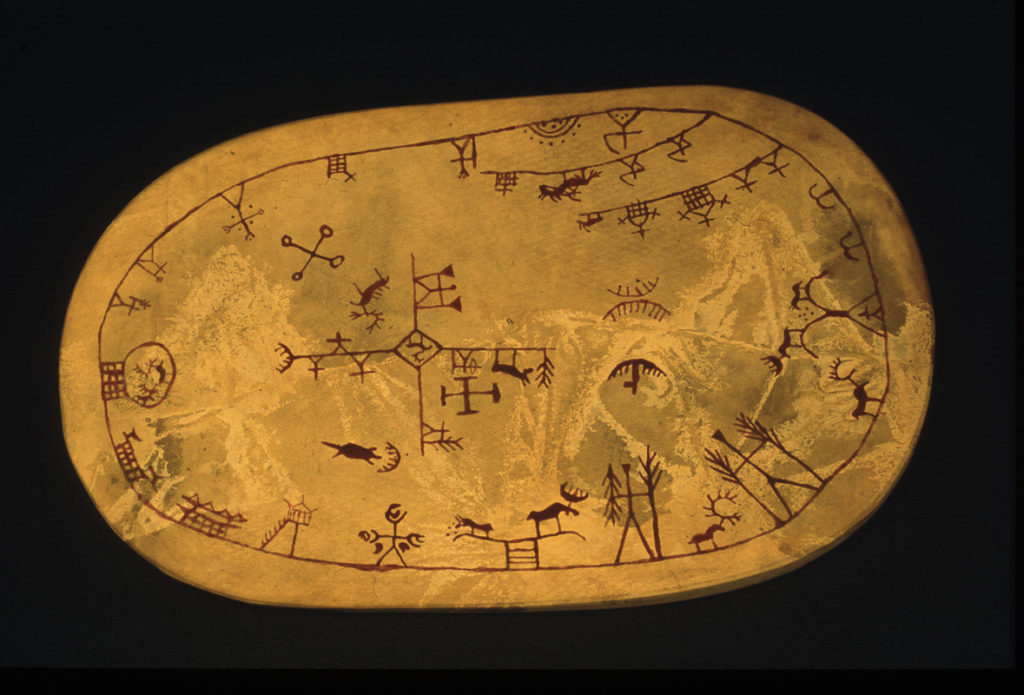
The Viking beliefs remained at Trondenes for centuries
The northernmost Norse areas were also among the regions where the old Asatru Norse religion lasted the longest. An exhibition at Trondenes Historical Center explains the history of three gods in particular. The one-eyed Odin was the most powerful of the gods who could transform into many figures; he was also the god of wisdom. His son, Thor, was a great warrior who fought against the Jotnes (the enemies of the gods) using his immense powers. The fertility goddess, Frøy, ruled over annual cycles of growth and harvest, over animals in heat and men’s virility. There were many other gods and mythological beings back then. It all took place along a timeline from the creation of the world via the battle against the Jotnes to Ragnarok, the doom of the world. A new world arose then. Our epochs falls somewhere between the creation and Ragnarok.
Sami religion lived side by side
The Sami religion existed side by side with the Asatru faith. The sun was a key primordial being in the Sami beliefs. The noaid (shaman) communicated with the hereafter on behalf of the Sami. He did this by beating his magic drum, singing joik and entering a trance. Then his soul could travel in time and space, presage and communicate with the gods of the Sami pantheon. Sacrificial sites (sieidis) are found in the wilderness of the north, often associated with boulders, mountains and lakes of unusual shapes. The two ethnic groups practised quite different religions.
Trondenes was essential to the drama surrounding the Christianisation of Norway
The writer of the Sagas, Snorri Sturlusson, described the dramas of the chieftain’s court at Trondenes under Olav the Holy and the Christianisation of Norway. The chieftains in the north asserted themselves against him and opposed the conversion to Christianity. The king resorted to boycotting; he forbade the selling of grain to the northerners. Asbjørn Sigurdson, chieftain of Trondenes, journeyed to his family at Avaldsnes near Karmsundet, where he could buy grain. An ally of the king, Tore Sel, intercepted Asbjørn’s ship on its way north to rob him of that much-needed grain. Asbjørn took revenge and killed Tore, being given the nickname the Scourge of Sel (Selsbane).
A revenge in two rounds
That rebellion was not graciously received by the king. Another of the king’s men killed Asbjørn while he was leaving Vesterålen. When the body of Asbjørn and the spear that killed him (Selshevneren, the avenger of Sel) were brought home to Trondenes, Asbjørn’s mother summoned a close ally of Asbjørn to Trondenes, Tore Hund from Bjarkøy. He swore revenge. Tore Hund used Selshevneren to kill Olav at the Battle of Stiklestad on 29 July 1030. King Olav was later canonised (made a saint) by the church. This is how Trondenes became the focal point of one of the most famous dramas in Norwegian history. Of course, much space has been dedicated to the drama in the exhibitions.
Christianity arrives
By the 1100s, however, the chieftains in the north had to agree to become part of the unified kingdom. The chieftains were probably also deprived of much of their landed properties, which fell to the crown and church estates. The Sami, on the other hand, did not become part of the realm. The Christianisation of the Sami took nearly 600 years. The ethnic divide that had existed was reinforced by a religious divide.
Stockfish was the realm’s economic backbone in the Middle Ages
With Christianity, stockfish took over the role of the most important commodity in Europe. Cod can be dried without salt or smoking in the coastal climate of Northern Norway and was a product that was easy to export. In Europe, the gentry ate stockfish during Lent so they could eat animal proteins without breaking the rules, while most people had to stick to a vegetarian diet. From the 13th century onwards, the stockfish trade was the basis for Northern Norway’s economic growth, and stockfish became the country’s most valuable export item. In Trondenes, people paid 6000 kilos of stockfish annually to lease land and as a tax in the 15th century. Such large sums can be used to build a church.
The church at Trondenes was built in two stages
Trondenes Church is the best preserved medieval church in the northernmost reaches of Norway. Construction may have started around the year 1180, and the choir was completed by the year 1250. It took a while before the nave was built, but construction did start around 1400. The roof was laid by approx. 1450. This is one of the largest country churches from the Middle Ages in Norway.
It has been recreated at the Trondenes Historical Center
You can and should see the church, which is only a short walk to the north of the center. The recreation at center is still worth a visit. The first thing that strikes you is the brilliant colours. Cobalt blue and bright red, among others, which one might find a little gaudy today. In the 15th century, however, the effects were not spared and the interior was a colourful performance for people who otherwise lived simple and poor lives.
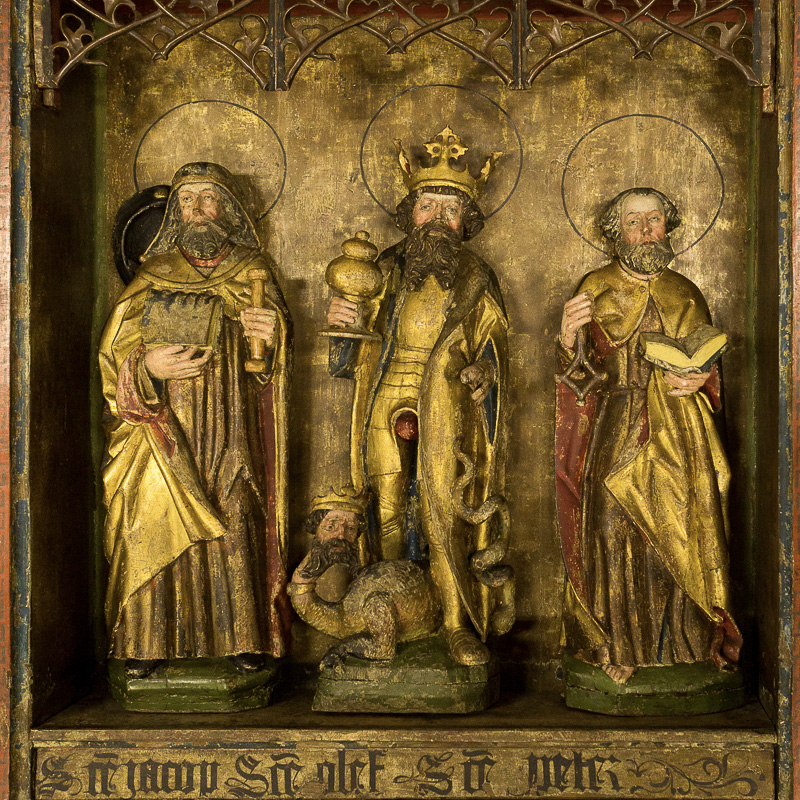
The altarpiece from Kvæfjord is the pearl in the exhibition
The Kvæfjord altarpiece was created in approx. 1510 in Lübeck and somehow found its way north as part of the stockfish trade. Saint Olav is the focus of the altarpiece, surrounded by other popular saints from the time. The decor is elegant in the last flowering of the Gothic style before the Reformation took over. The statues of saints in Gothic style also originate from Kvæfjord Church.
We are suddenly surrounded by the Middle Ages
There is always a difference between theory and practice. The aesthetically pleasing and well-explained exhibitions lead us to the harsh reality of farm life on the Trondenes medieval farm. The hens run wild here, sheep graze and Lame Haldor walks around repairing fences. Flax and herbs are grown, and there is a fire on the hearth in the årestua (open-hearthed house). This is how people lived 800 years ago.
The Trondenes medieval farm was a larger farm
The Trondenes medieval farm belonged to the chieftain of Trondenes. Asbjørn Selsbane lived here, but the farm was confiscated by the king as the region fell to Christianity. King Magnus gave the farm to the church in 1114. This meant that those who lived here after that were tenants who were trying to pay off a debt to the church by paying rent. The large farm is an indication that the local community of Trondenes must still be quite big.
Earthen houses are both warm and pleasant
The open-hearth building (årestua) is the beating heart of the farm. It was rebuilt on the floor plans of the ruins of several similar houses excavated around Trondenes. There are thick earth walls at the ends, and a large room clad on the inside with wood within a pole structure. The floors are made of wood. Wood floors were found in some of the excavated houses, but not all the houses had wood floors. The designers visited Iceland during its construction where people had lived in similar earthen houses until the early 20th century.
The smoke vent in the roof provides light and air
The hearth is located in the middle of the room. There is an opening in the ceiling to let out the smoke. It also allows sunlight to fill the room. The hearth becomes the light source during the dark seasons and at night, while simple cod liver oil lamps have also been found in the ruins. The whole household lived in the same room. In the evening they must have gathered around the hearth doing handicrafts, telling stories and perhaps singing together. Such evenings must have been pleasant after a long day of work.
Leif and Jorunn are the masters of the household
Farmer Leif spends much of his time at sea, as has always been the custom in the far north. Otherwise, he likes spending time in the boathouse where he can drink a bowl of beer with Mikkel the Sami. He is only moderately concerned with spiritual things, which his wife Jorunn does not like. She oversees the house and is the closest ally of the village priest. Pious as she is, she likes to point out the sins of others.
They have four children
Sverre is the eldest son and probable heir. He is engaged to Kristin from Kulseng, even though he has a child with Frøydis the maid. Olve is the second oldest and more academic than practical. Magnhild, aged ten, has learned to interpret runes, which was generally not entrusted to girls. But she learned to read rune sticks and knows many mystic secrets. Ulf, six years old, cannot be trusted with such knowledge because he retells everything he hears without shame.
We need to watch out for Grubby Gunvor
Grubby Gunvor is far down the social ladder. She lives in a Sami turf hut at the edge of the forest. She stays away from the church and prefers the ancient spiritual powers. She advises the villagers about folk medicines and medical problems, about abortion and predicts love, yet people are afraid of her and her mysterious powers.
The gallery of characters is large
Lame Haldor should have gone to sea like all the men, but he probably gets terribly seasick and blames his lame foot. Instead, you will see him repairing fences and doing other chores around the yard. Uncle Magnus is a ‘modern Viking’ who fights and drinks and was once unlucky enough to have killed another man while drunk. Arne the Monk is an apprentice priest who brought new ideas about gardening to Trondenes after living at a monastery in the south.
The stave church rises
A stave church was erected on the farm in the summer of 2021. There was a stave church at Trondenes from the time of the visit of King Magnus in 1114. We have no idea what that church might have looked like, so the South Troms Museum chose to use Norway’s smallest preserved stave church from Haltdalen in South Trøndelag as a model. Much of the construction took place in Salangen, a region of vast forests, as was perhaps logical at the time as well. Then it was put together using traditional tools, with tongue and groove techniques. Nails are sparsely used – in ceilings and floors – as was common in the Middle Ages.
The stave church was eventually decorated
The stave church is small by our standards. Nevertheless, it dominates the cultural landscape with its high-rising shape near the modest Viking home. The congregation stood during mass, which did not last long. Only the elders were allowed to sit on a bench. The church will be decorated and adorned in years to come to match the churches from the 13th century – full of incense, mystery and colour.
Leeks and linen are women’s work
An important chore for the women at the farm was linen cultivation. Flax is grown during the short summer season. The flax is harvested, followed by soaking, drying and a painstaking process of making linen threads. Finally, the threads were woven. There is also an herb garden with the plants that Arne the Monk brought from the monastery in the south. Watercress, Angelica archangelica, was a vegetable, medicine and a spice. Grubby Gunvor says the red oil from St. John’s wort comes from Odin’s blood, but Jorunn thinks it is from the baptism of John the Baptist. Caraway is good for urinary tract infections, sage helps women during childbirth and victory onions are good for toothache.
Frequently asked questions
Trondenes is a point or peninsula found just outside the built-up area of the city of Harstad.
Buses go to Trondenes from downtown Harstad, ask for the timetable at the tourist office. If you drive yourself, there is good parking just outside the museum. We tried to go by e-bike from the Tourist Office, and that was GREAT fun. A walk will take you a good half hour, use the coastal path. In short; a stop at the Tourist information
There is plenty to see out here. The Trondenes Historical Centre also has an exhibit on the 2nd World War, which could be accompanied by a walk to the remnants of the prisoner camp near the church. A marked historic trail takes you from the prisoner camp to various other sites, ranging from the Viking age to WWII. The church of Trondenes is a must. The giant Adolf Gun from WWII is inside the military fortress of Trondenes, and is only occasionally available these days. Contact the Tourist Board!
No, they are busy, remember. However in the summer opening hours, there are always 2-3 farm dwellers around, ready to show you around and tell you about their lives.
The farm is mostly inhabited in the summer school holiday. A walk around the farm, with the main house and the stave church are recommended, as long as the snow and ice conditions allow it.
Oh, the kids love it. They can make old music instruments, learn to shoot with a bow and arrow (these days, girls can have a try too, back in 1200 that was maybe not the case), feed the chicken and join in at the farmwork in general.
Trondenes Historic Centre has an excellent cafe with coffee, waffles, sandwiches and salads. It’s open all year, except some of the major public holidays.
Visit Harstad is the homepage for the city and the surrounding area. Here you get to know everything about attractions, accommodation, food and activities.
